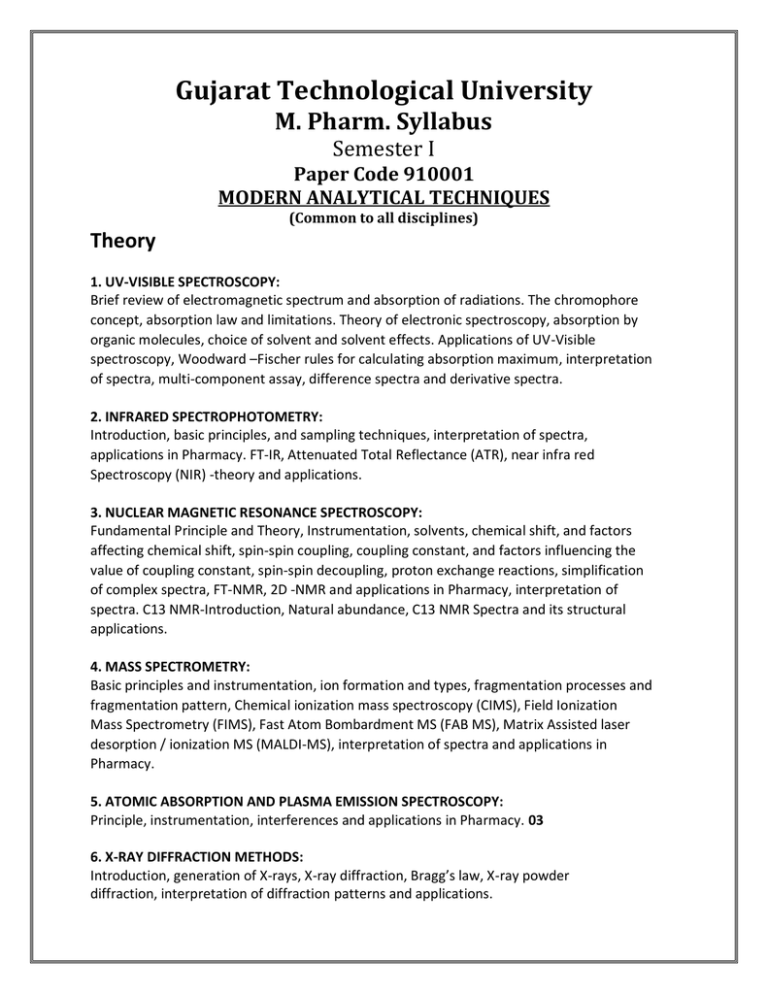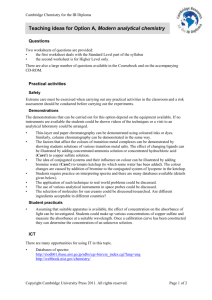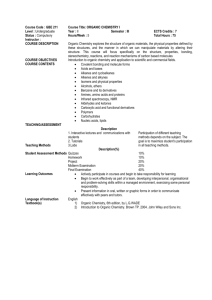Gujarat Technological University M. Pharm. Syllabus Semester I Theory
advertisement

Gujarat Technological University M. Pharm. Syllabus Semester I Paper Code 910001 MODERN ANALYTICAL TECHNIQUES (Common to all disciplines) Theory 1. UV-VISIBLE SPECTROSCOPY: Brief review of electromagnetic spectrum and absorption of radiations. The chromophore concept, absorption law and limitations. Theory of electronic spectroscopy, absorption by organic molecules, choice of solvent and solvent effects. Applications of UV-Visible spectroscopy, Woodward –Fischer rules for calculating absorption maximum, interpretation of spectra, multi-component assay, difference spectra and derivative spectra. 2. INFRARED SPECTROPHOTOMETRY: Introduction, basic principles, and sampling techniques, interpretation of spectra, applications in Pharmacy. FT-IR, Attenuated Total Reflectance (ATR), near infra red Spectroscopy (NIR) -theory and applications. 3. NUCLEAR MAGNETIC RESONANCE SPECTROSCOPY: Fundamental Principle and Theory, Instrumentation, solvents, chemical shift, and factors affecting chemical shift, spin-spin coupling, coupling constant, and factors influencing the value of coupling constant, spin-spin decoupling, proton exchange reactions, simplification of complex spectra, FT-NMR, 2D -NMR and applications in Pharmacy, interpretation of spectra. C13 NMR-Introduction, Natural abundance, C13 NMR Spectra and its structural applications. 4. MASS SPECTROMETRY: Basic principles and instrumentation, ion formation and types, fragmentation processes and fragmentation pattern, Chemical ionization mass spectroscopy (CIMS), Field Ionization Mass Spectrometry (FIMS), Fast Atom Bombardment MS (FAB MS), Matrix Assisted laser desorption / ionization MS (MALDI-MS), interpretation of spectra and applications in Pharmacy. 5. ATOMIC ABSORPTION AND PLASMA EMISSION SPECTROSCOPY: Principle, instrumentation, interferences and applications in Pharmacy. 03 6. X-RAY DIFFRACTION METHODS: Introduction, generation of X-rays, X-ray diffraction, Bragg’s law, X-ray powder diffraction, interpretation of diffraction patterns and applications. 7. OPTICAL ROTARY DISPERSION: Principle, Plain curves, curves with cotton effect, octant rule and its applications with example, circular dichroism and its relation to ORD. 8. THERMAL METHODS OF ANALYSIS: Theory, instrumentation and applications of Thermo Gravimetric Analysis (TGA), Differential Thermal Analysis (DTA), Differential Scanning Calorimetry (DSC). And Thermo Mechanical Analysis (TMA). 9. CHROMATOGRAPHIC TECHNIQUES: a) Classification of chromatographic methods based on mechanism of separation. Theories of chromatographic separation. b) Principles, elution techniques, instrumentation, derivatization and applications of gas chromatography, HPLC and HPTLC. c) Principles, elution techniques, applications of ion exchange and ion pair chromatography, affinity chromatography, size exclusion chromatography, and chiral chromatography, super fluid chromatography (SFC), GC-MS and LC-MS. 10. ELECTROPHORESIS: Theory and principles, classifications, instrumentation, moving boundary electrophoresis, Zone Electrophoresis (ZE), Isoelectric focusing (IEF) and applications. 11. RADIO IMMUNO ASSAY: Introduction, Principle, Theory and Methods in Radio Immuno Assay, Related Immuno Assay procedures and applications of RIA Techniques. Enzyme immuno assay- ELISA and EMIT. 12. Reference standards source, preparation, characterization, usage, storage and records. MODERN ANALYTICAL TECHNIQUES Practicals 1. Use of colorimeter for analysis of Pharmacopoeial compounds and their formulations. 2. Use of Spectrophotometer for analysis for Pharmacopoeial compounds and their formulations. 3. Simultaneous estimation of combination formulations (minimum of 4 experiments): e.g. a. Vitamins b. Oral antidiabetics c. NSAIDs d. Antimicrobials e. Antihistamines f. Antihypertensive etc. 4. Effect of pH and solvent on UV Spectrum of certain drugs. 5. Experiments on flame photometry. 6. Use of fluorimeter for analysis of Pharmacopoieal compounds. 7. Experiments on Electrophoresis. 8. Experiments of Chromatography. (a) Thin Layer Chromatography. (b) Paper Chromatography. 9. Experiments based on HPLC & GC. 10. IR, NMR and Mass Spectroscopy – Interpretation of spectra & Structural elucidation (atleast for 4 compounds each). 11. Any other relevant exercises based on theory. Recommended books: 1. Spectrometric identification of Organic Compounds, Robert. M. Silverstein, Basseler, Morril (John Wiley and Sons. N.Y). 2. Spectroscopy of Organic Compounds by P. S. Kalsi. 3. Principles of Instrumental Analysis by Donglas A. Skoog, James, J. Leary, 4th Edition. 4. Pharmaceutical Analysis – Modern Methods – Part A, Part B, James W. Munson 2001. 5. Organic Spectroscopy – William Kemp, 3rd Edition. 6. Chromatographic Analysis of Pharmaceuticals, John A. Adamovics, 2nd Edition. 7. Practical Pharmaceutical Chemistry, Part two, A. H. Beckett & J. B. Stenlake – 4th dition. 8. Instrumental Methods of Analysis – Willard, Merritt, Dean, CBS, Delhi. 9. Techniques and Practice of Chromatography – Raymond P. W. Scott, Vol. 70. 10. Identification of Drugs and Pharmaceutical Formulations by Thin Layer Chromatography – P. D. Sethi, Dilip Charegaonkar, 2nd Edition. 11. HPTLC – Quantitative Analysis of Pharmaceutical Formulations – P. D. Sethi. 12. Liquid Chromatography – Mass Spectrometry, W. M. A. Niessen, J. Van Der Greef, Vol.58. 13. Modern Methods of Pharmaceutical Analysis, Vol.1, 2, RE Schirmer,Franklin Book 14. Colorimetric Methods of analysis- F. D. Snell and C. T. Snell (Van Nostrand Reinhold Company, N.Y.). 15. Indian Pharmacopoeia 16. British Pharmacopoeia 17. U.S. Pharmacopoeia 18. Clarke’s Analysis of Drugs and Poisons, A.C.Moffat, M. David Osselton, Brain Widdop, L. Y. Galichet. 3rd edition, Pharmaceutical Press Text book of Pharmaceutical Analysis, K. A. Connors, 3rd Ed., John Wiley & Sons, New York. Gujarat Technological University M. Pharm. Syllabus Semester I 910101 : Subject of Specialization Paper – I Advanced Organic Chemistry – I Theory Course Content: 1. Chemical Bonding and Structure: Chemical Bonding, Bond Energies, Orbital Theory, Orbital Hybridization, Resonance, Electronegativity, Polarity, Hyperconjugation. 2. Chemical Reactivity and Molecular Structure Kinetics, Stearic, Inductive and electrostatic effect on reactivity, Acids and Bases. 3. Various Reaction Mechanisms a. Substitution Reaction: Nucleophilic substitution reaction in aliphatic systems, SN1, SN2 reactions, Hydride transfer reaction, Cram’s rule, Participation of neighbouring group in nucleophilic substitution reaction and rearrangements. Aromaticity, electrophilic and nucleophilic substitution in aromatic systems, Reactivity, orientation in electrophilic substitution. b. Elimination Reaction: Beta Elimination reactions, E1, E2 and E1cb mechanisms, Hoffman and saytzeff’s rule for elimination. c. Addition Reaction: Electrophilic and Nucleophilic additions, Stereochemiistry involved, Markonikov’s rule. d. Rearrangement Reactions: Transannular rearrangement, Pinacol rearrangements, Beckman rearrangement, Hofmann rearrangement. e. Free Radical Reaction: Formation, Detection, Reactions, Homolysis and free radical displacements, addition and rearrangements of free radicals. 4. Reactions of carboxylic acids and esters BAC2, AAc2, BAL2, BAL1, AAL1, Claisen condensation, decarboxylation, carbanions, enolisation, keto-enol equilibria 5. Y-lides: Introduction, generation and reactions involving phosphorus, sulphur and nitrogen ylides. 6. Photochemistry: Theory, energy transfer, characteristics of photoreactions, typical photochemical reactions 910101: Advanced Organic Chemistry – I PracticalS Laboratory examination including oral and practical examination in general course illustrative of theory section in the syllabus. Reference Books: 1. Advanced Organic Chemistry – Reaction, Mechanism and Structure – J. March, John Wiley & Sons, New York. 2. Advanced Organic Chemistry Part – A & B – F. A. Carey & R. J. Sundberg, Kluwer Academic / Plenum Publishers, New York. 3. Organic Chemistry, Clayden, Greeves, Waren and Wothers, Oxford University Press, New York. 4. Organic Chemistry, G. Marc Loudon, Oxford University Press., New York. 5. Organic Synthesis, Collective Volumes, Ed. W. E. Noland, John Wiley & Sons, New York. 6. Strategic Application of named reaction in organic synthesis by Laszlo Kurti & Barbara Czako, Elsevier Academic Press. 7. Vogel’s textbook of practical organic chemistry, Pearson Education Ltd. 8. “Experimental Organic Chemistry” L. M. Harwood, L. J. Moody, J. M. Percy, Blackwell Science. 9. Techniques and Experiment of Organic Chemistry, Addison Ault, University Science Books. 10. Introduction to Organic Laboratory Techniques, A Microscale Approach, Donald L. Pavia, Gary M. Lampman, George S. Kriz, Harcourt College Pub. Gujarat Technological University M. Pharm. Syllabus Semester I 910201: Chemistry of Natural Products Theory Course Content: 1. Carbohydrates: Brief introduction, Configuration of monosaccharids, ring structure of monosaccharides, disaccharides – determination of structures of sucrose, maltose and lactose, Polysaccharides – cellulose and starch, Introduction to pectin and pectic substances 2. Amino acids and polypeptides: Introduction, classification, synthesis of amino acids, protein classification, Synthesis of naturally occurring proteins, structure of polypeptides, amino and carboxyl end degradation, polypeptide synthesis, composition, structure and chemistry of oxytocin, insulin and angiotensin, peptides of medicinal importance. 3. Alkaloids: Classification, general methods of degradation and structure determination, morphine, ergotamine, reserpine, colchicine, vinca and podophyllum alkaloids. 4. Steroids: Stereochemistry, conformational studies of steroidal nucleus, chemistry of cholesterol, stereochemistry of side chain at C-17, cholic acid, vit. D3, cortisone, aldosterone. 5. Anthocyanins: Introduction, general nature, synthesis, structure of anthocyanidin, flavones, isoflavones and depsides. 6. Purines and nucleic acids 7. Heterocyclic Chemistry Introduction, nomenclature, properties, synthesis and reactions involved in five and six member heterocycles. Heterocycles with one, two or more than two hetero atoms, biological importance of heterocles. Reference Books: 1. Organic Chemistry, Vol. I & II by Finar, Pearson Education. 2. Organic Chemistry, R. T. Morrison, R. N. Boyd, Prentice-Hall of India Pvt. Ltd., New Delhi. 3. Organic Chemistry, G. Marc Loudon, Oxford University Press., New York.




